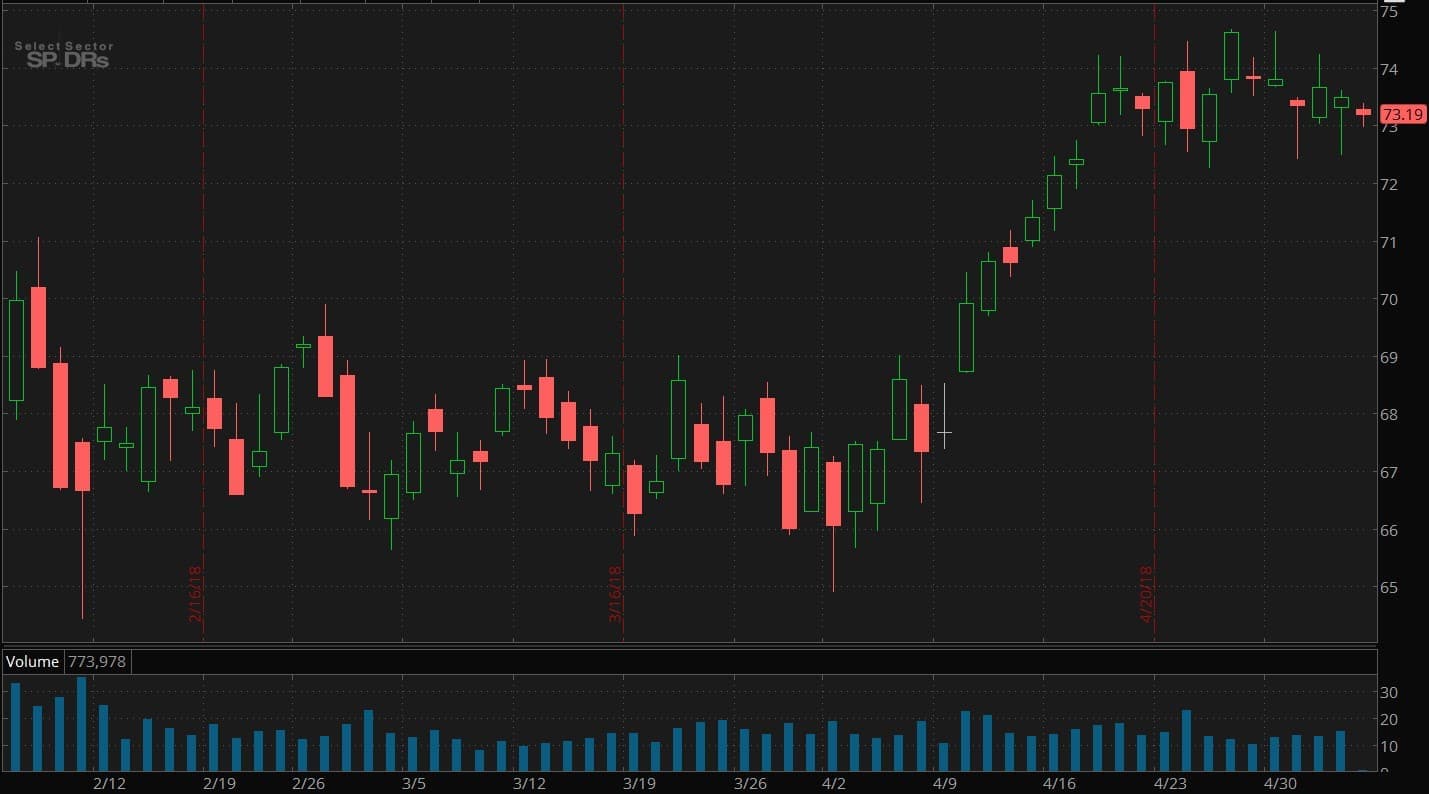When considered on a year on year basis, this has been a remarkable earnings season so far for the energy sector, with a market leading 89.1 percent EPS growth rate. Investors who saw that coming, however, have not necessarily made boatloads of money, as many stocks in the sector have not responded positively to their own reports, which of course raises the question why. As always there is not one simple answer. There are a number of factors that have caused some stocks to react to earnings disappointingly, and as we sort through them it seems that there are two main lessons to be learned.
1. Expectations Matter
It doesn’t take a genius chart reader to look at a one-year chart of oil prices and conclude that this year’s calendar Q1 results were going to be significantly better than last years. In the first three months of 2017, WTI averaged around $50 per barrel and was coming off an extended period in the $40s that scared the pants off the industry. On the other hand, Q1 2018 saw prices holding above $60 and continuing to climb after a strong run up in the second half of last year.
Wall Street analysts, after extensive research to justify their big salaries, concluded that as a result, earnings would be good.
They raised their EPS forecasts significantly, and the price of most oil stocks went with them. Even companies that had disappointed last month saw their stock benefit from that. Exxon Mobil (XOM), for example, jumped over 10% in the month leading…
When considered on a year on year basis, this has been a remarkable earnings season so far for the energy sector, with a market leading 89.1 percent EPS growth rate. Investors who saw that coming, however, have not necessarily made boatloads of money, as many stocks in the sector have not responded positively to their own reports, which of course raises the question why. As always there is not one simple answer. There are a number of factors that have caused some stocks to react to earnings disappointingly, and as we sort through them it seems that there are two main lessons to be learned.
1. Expectations Matter
It doesn’t take a genius chart reader to look at a one-year chart of oil prices and conclude that this year’s calendar Q1 results were going to be significantly better than last years. In the first three months of 2017, WTI averaged around $50 per barrel and was coming off an extended period in the $40s that scared the pants off the industry. On the other hand, Q1 2018 saw prices holding above $60 and continuing to climb after a strong run up in the second half of last year.
Wall Street analysts, after extensive research to justify their big salaries, concluded that as a result, earnings would be good.
They raised their EPS forecasts significantly, and the price of most oil stocks went with them. Even companies that had disappointed last month saw their stock benefit from that. Exxon Mobil (XOM), for example, jumped over 10% in the month leading up to their release.
The point here is that when prices reflect high expectations, there is only really one way to go…down. There are three possibilities when that is the case: earnings can miss expectations, meet them or beat them. If they miss, the selloff is dramatic for obvious reasons. If they meet, it is often still disappointing, even if the results are good. Even after a beat, the positive reaction in the stock is often relatively muted. If everyone is already long, who is going to buy after the numbers?
The end result of all this is that high expectations, by both analysts and traders, result in all the potential good news being priced in. Expectations matter.
2. Understand the Effects of Higher Prices on Different Stocks:
There is a tendency for those new to the energy sector to see higher oil prices as a panacea for whatever ails the industry. There is no doubt that as in any commoditized industry, the price that can be realized for the product is important, but higher prices are not always good news for everybody. Refiners, for example, face higher input costs and therefore squeezing of margins as prices rise. Retailers are put in the same position, with the higher prices also probably causing demand to fall. On the other hand, exploration and production (E&P) companies receive more money for what they pump, with most costs remaining essentially fixed.
Over time, the inbuilt hedge against price fluctuations of being in all aspects of the oil business serves the big, integrated firms such as Exxon (XOM) and Chevron (CVX) well, but in the short term it makes them unsuitable stocks for playing higher oil. E&P companies such as Concho Resources (CXO) are far better for that, and in this earnings season, they have generally responded better to good news or bad.

(Click to enlarge)
The above chart for the energy sector ETF, XLE, shows the effect of high expectations and the varied impact of high prices perfectly. As earnings season got underway and everybody got excited about oil, XLE shot up. Then, when the reality of mixed results as compared to estimates set in, the move stalled, and we have been moving sideways since reports started coming in. That should tell you that if you are looking to trade in front of what earnings are left, concentrating on E&P and regarding even a small beat as a miss is the way to go.















